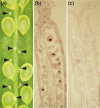Heat shock factor HSFB2a involved in gametophyte development of Arabidopsis thaliana and its expression is controlled by a heat-inducible long non-coding antisense RNA
- PMID: 24874772
- PMCID: PMC4099531
- DOI: 10.1007/s11103-014-0202-0
Heat shock factor HSFB2a involved in gametophyte development of Arabidopsis thaliana and its expression is controlled by a heat-inducible long non-coding antisense RNA
Abstract
Heat stress transcription factors (HSFs) are central regulators of the heat stress response. Plant HSFs of subgroup B lack a conserved sequence motif present in the transcriptional activation domain of class A-HSFs. Arabidopsis members were found to be involved in non-heat shock functions. In the present analysis we investigated the expression, regulation and function of HSFB2a. HSFB2a expression was counteracted by a natural long non-coding antisense RNA, asHSFB2a. In leaves, the antisense RNA gene is only expressed after heat stress and dependent on the activity of HSFA1a/HSFA1b. HSFB2a and asHSFB2a RNAs were also present in the absence of heat stress in the female gametophyte. Transgenic overexpression of HSFB2a resulted in a complete knock down of the asHSFB2a expression. Conversely, asHSFB2a overexpression leads to the absence of HSFB2a RNA. The knockdown of HSFB2a by asHSFB2a correlated with an improved, knockdown of asHSFB2a by HSFB2a overexpression with an impaired biomass production early in vegetative development. In both cases the development of female gametophytes was impaired. A T-DNA knock-out line did not segregate homozygous mutant plants, only heterozygots hsfB2a-tt1/+ were viable. Approximately 50% of the female gametophytes were arrested in early development, before mitosis 3, resulting in 45% of sterile ovules. Our analysis indicates that the "Yin-Yang" regulation of gene expression at the HSFB2a locus influences vegetative and gametophytic development in Arabidopsis.
Figures




Similar articles
-
XBAT31 regulates reproductive thermotolerance through controlling the accumulation of HSFB2a/B2b under heat stress conditions.Cell Rep. 2024 Jun 25;43(6):114349. doi: 10.1016/j.celrep.2024.114349. Epub 2024 Jun 13. Cell Rep. 2024. PMID: 38870009
-
Functional analysis of an Arabidopsis transcription factor WRKY25 in heat stress.Plant Cell Rep. 2009 Apr;28(4):683-93. doi: 10.1007/s00299-008-0666-y. Epub 2009 Jan 6. Plant Cell Rep. 2009. PMID: 19125253
-
Arabidopsis HsfA1 transcription factors function as the main positive regulators in heat shock-responsive gene expression.Mol Genet Genomics. 2011 Dec;286(5-6):321-32. doi: 10.1007/s00438-011-0647-7. Epub 2011 Sep 20. Mol Genet Genomics. 2011. PMID: 21931939
-
HSFA2 orchestrates transcriptional dynamics after heat stress in Arabidopsis thaliana.Transcription. 2016 Aug 7;7(4):111-4. doi: 10.1080/21541264.2016.1187550. Epub 2016 Jul 6. Transcription. 2016. PMID: 27383578 Free PMC article. Review.
-
The diversity of plant heat stress transcription factors.Trends Plant Sci. 2007 Oct;12(10):452-7. doi: 10.1016/j.tplants.2007.08.014. Epub 2007 Sep 7. Trends Plant Sci. 2007. PMID: 17826296 Review.
Cited by
-
Tissue-specific transcriptomic analysis uncovers potential roles of natural antisense transcripts in Arabidopsis heat stress response.Front Plant Sci. 2022 Sep 8;13:997967. doi: 10.3389/fpls.2022.997967. eCollection 2022. Front Plant Sci. 2022. PMID: 36160979 Free PMC article.
-
New technologies accelerate the exploration of non-coding RNAs in horticultural plants.Hortic Res. 2017 Jul 5;4:17031. doi: 10.1038/hortres.2017.31. eCollection 2017. Hortic Res. 2017. PMID: 28698797 Free PMC article. Review.
-
A Nucleus-Localized Long Non-Coding RNA Enhances Drought and Salt Stress Tolerance.Plant Physiol. 2017 Nov;175(3):1321-1336. doi: 10.1104/pp.17.00574. Epub 2017 Sep 8. Plant Physiol. 2017. PMID: 28887353 Free PMC article.
-
Arabidopsis HEAT SHOCK TRANSCRIPTION FACTORA1b regulates multiple developmental genes under benign and stress conditions.J Exp Bot. 2018 May 19;69(11):2847-2862. doi: 10.1093/jxb/ery142. J Exp Bot. 2018. PMID: 29697803 Free PMC article.
-
A long noncoding RNA HILinc1 enhances pear thermotolerance by stabilizing PbHILT1 transcripts through complementary base pairing.Commun Biol. 2022 Oct 26;5(1):1134. doi: 10.1038/s42003-022-04010-7. Commun Biol. 2022. PMID: 36289367 Free PMC article.
References
-
- Bechtold N, Ellis J, Pelletier G. In-planta agrobacterium-mediated gene-transfer by infiltration of adult Arabidopsis thaliana plants. Comptes Rendus De L Academie Des Sciences Serie Iii-Sciences De La Vie-Life Sciences. 1993;316:1194–1199.
-
- Begum T, Reuter R, Schöffl F (2012) Overexpression of AtHsfB4 induces specific effects on root development of Arabidopsis. Mech Dev 130:54–60 - PubMed
-
- Beisel C, Buness A, Roustan-Espinosa IM, Koch B, Schmitt S, Haas SA, Hild M, Katsuyama T, Paro R. Comparing active and repressed expression states of genes controlled by the Polycomb/Trithorax group proteins. Proc Natl Acad Sci. 2007;104:16615–16620. doi: 10.1073/pnas.0701538104. - DOI - PMC - PubMed
MeSH terms
Substances
LinkOut - more resources
Full Text Sources
Other Literature Sources
Molecular Biology Databases

